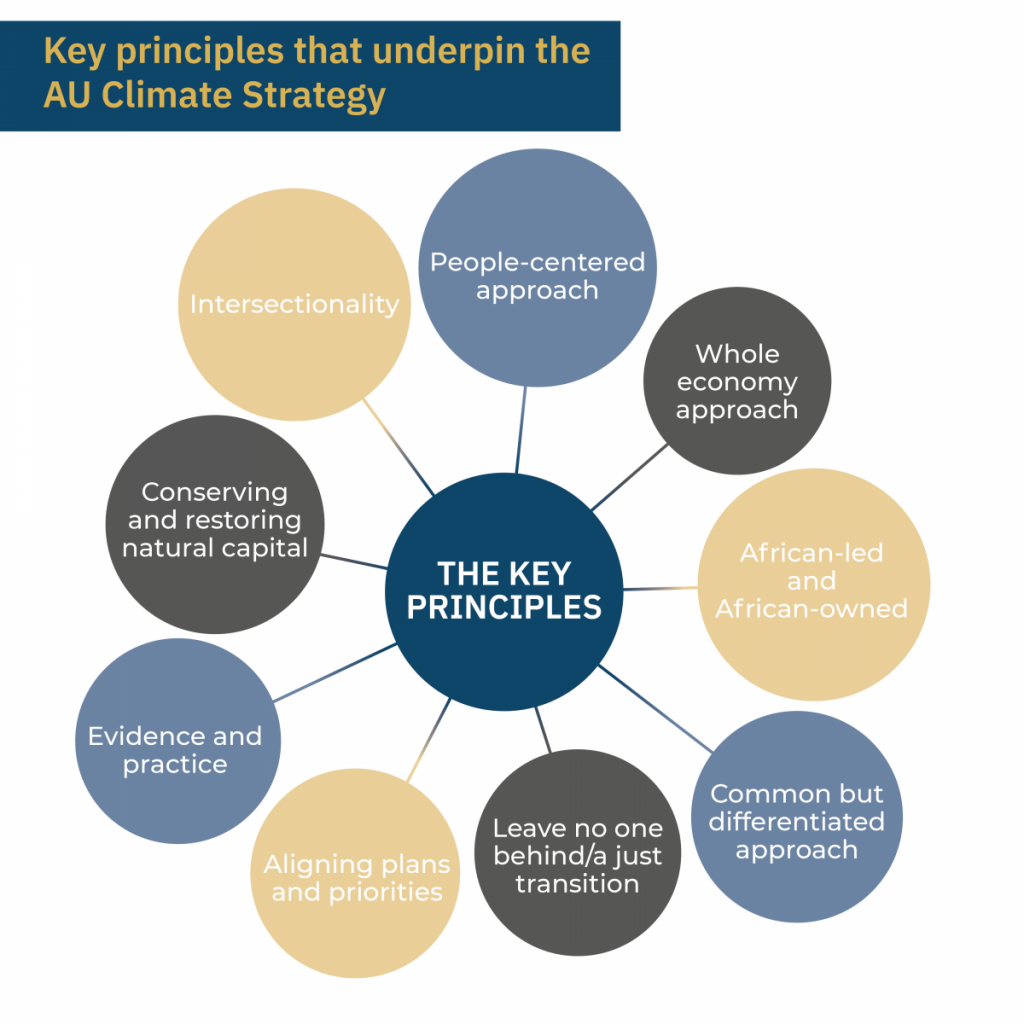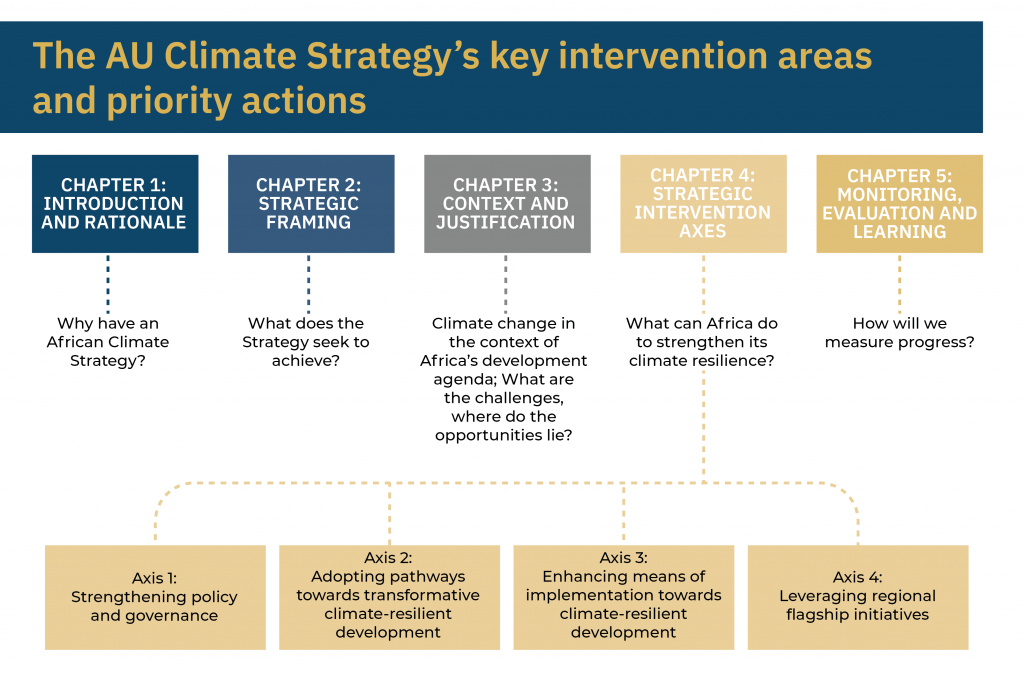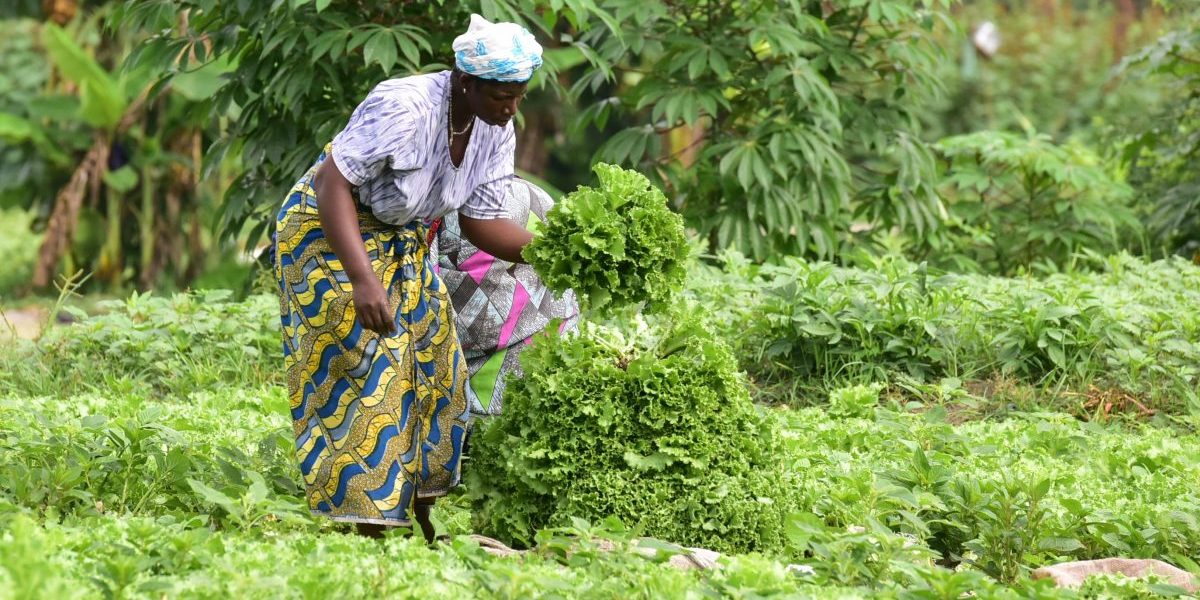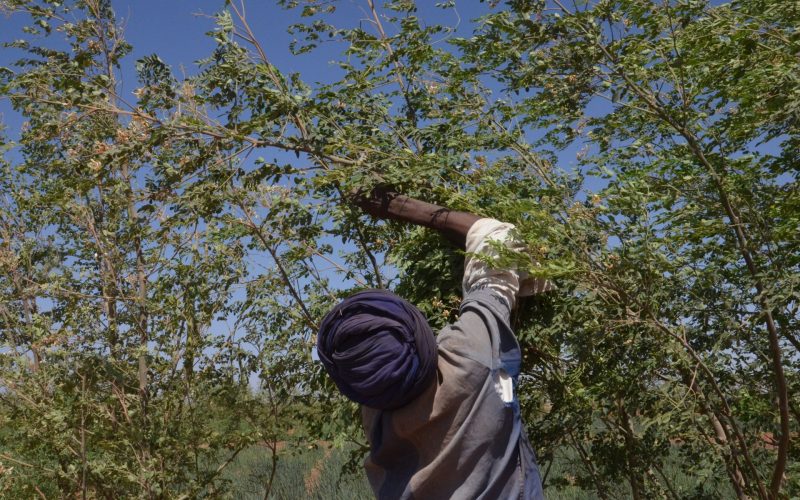Recommendations
- Continue to build political momentum and activate public support for the strategy by highlighting its value addition for member states, regional organisations and non-governmental communities.
- Use COP27 to showcase Africa’s climate priorities and commitments, ensure alignment with the continent’s key negotiating positions, and encourage national action on climate planning through the revision of Nationally Determined Contributions, or NDCs, and the development of long-term strategies.
- Focus on translating the policy commitments of the strategy into visible and implementable actions by building specific mechanisms for robust implementation, dissemination, monitoring and resource mobilisation.
- Identify entry points for partnership development and cooperation, including through support for existing continental flagship initiatives and programmes, as well as financial and technical support for the coordination and implementation of the strategy.
Executive summary
Climate change is an existential threat to Africa’s communities, ecosystems and economies. It places the continent’s developmental gains, its prosperity and the livelihoods of its people in jeopardy. To address this challenge, Africa has developed a collective, regional response to climate change and an action plan – both to enhance the adaptative capacity and resilience of the continent and to achieve long-term, transformative low-emission, climate-resilient development. The AU’s Climate Change and Resilient Development Strategy and Action Plan seeks to harmonise the continent’s approach to climate change over the next decade, setting out the guiding principles, priorities and action areas for enhanced climate cooperation. Informed and guided by the existing climate efforts of African countries, the strategy provides a framework around which Africa, as a continent, can build resilient societies, unlock mitigation potential, leverage the opportunities of a burgeoning green economy and develop partnerships in support of a just, inclusive and equitable transition. A key determinant of the strategy’s long-term success will be its ability to transform these prescriptive intentions into meaningful action by identifying specific entry points for joint execution. The strategy’s thematic and non-binding nature can support these implementation goals by complementing national- and regional-level action.
Introduction
On 6 February 2022 the AU Heads of State Summit endorsed the African Climate Change and Resilient Development Strategy and Action Plan (2022–2032)1The strategy was endorsed at the 35th Ordinary Session of the AU Assembly (Heads of State and Government Session) on February 6, 2022. – the continent’s first collective climate response framework. Since 2014, when a first draft was developed, the continent has been grappling with the endorsement of a consolidated framework for climate action.
This regional climate strategy comes at an important time, with the latest science clearly illustrating that more ambitious climate action is needed this decade if the globe is to achieve carbon neutrality by 2050 and, ultimately, achieve the Paris Agreement goal of limiting the global average temperature increase to 1.5°C above pre-industrial levels. There is also a pressing need to support adaptation to climate change, and address loss and damage. This comes against a background of warnings from the scientific community that accelerated climate change will have severe impacts on developing countries, with the Africa region particularly vulnerable.2Intergovernmental Panel for Climate Change, Working Group 1, Sixth Assessment Report: Regional Fact Sheet – Africa (Geneva: IPCC, 2021).
The adoption of the strategy is timely, as the continent prepares for the 27th Conference of the Parties (COP27) of the UN Framework Convention on Climate Change (UNFCCC), to be hosted in Egypt in November 2022 – widely billed as an ‘Africa COP’. A well-orchestrated and coordinated agenda on climate change, which lays out specific priorities and calls for support, can encourage Africans to speak with one voice. It can also strengthen the continent’s international presence and negotiating power, and ultimately help it to attain its climate goals, such as attracting additional climate finance, particularly for adaptation.
A regional response to climate action
It is a foundational principle of the Paris Agreement process that countries respond to climate change in a self-determined manner, based on their unique circumstances and capacities to respond. While recognising differences in national contexts, the African Climate Change Strategy seeks to promote a regional response to climate change, building upon the shared challenges and opportunities facing the continent. This includes plans to leverage natural endowments, renewable energy potential, nature-based solutions, transformative industrial pathways, green and circular economy approaches, and the region’s large and active youth demographic.
The strategy supports the commitments made by African countries under the UNFCCC, including the promotion of low-emission growth pathways aligned with the 1.5°C Paris Agreement goal. As such, this strategy is guided by the existing national climate efforts of AU member states, as expressed through their current Nationally Determined Contributions (NDCs), national adaptation plans and long-term decarbonisation visions. The strategy also promotes the integration of continental institutions, strategies and decisions across a number of sectors and themes. It is especially focused on the continent’s broader sustainable development goals framed within Agenda 2063, as well as its Green Stimulus Programme and Green Recovery Action Plan. The strategy further seeks alignment with a range of global frameworks, including the UN’s Agenda 2030 Sustainable Development Goals, the Sendai Framework for Disaster Risk Reduction and the Convention for Biological Diversity.
The strategy will be revised every five years and is therefore designed to be a living document that will keep pace with the latest science, technological advancements and other global, continental, sub-regional and national developments. This revision process will boost performance and accountability tracking, ensuring that mid-term goals are prioritised and accomplished.
Recognising that support is needed for bold and ambitious climate action, the strategy wants to enhance inclusion, alignment, cooperation, engagement and ownership across all spheres of government and stakeholder groupings, by developing a consolidated framework around which partnerships can be built. The involvement of a broad stakeholder base of state and non-state actors is needed to advocate for the strategy’s rapid implementation and to support its ultimate goal of ‘collective action and enhanced cooperation in addressing climate change issues that improves livelihoods and well-being, promotes adaptation capacity, and achieves low-emission, sustainable economic growth’.3AU Commission, The AU Climate Change and Resilient Development Strategy and Action Plan (2022–2032) (Addis Ababa: AUC, 2022).
A key question remains as to whether the strategy will support the mobilisation of commitments from African governments and activate international financing for continental efforts.

Key principles that underpin the strategy
In support of its overall vision to achieve a ‘sustainable, prosperous, equitable and climateresilient Africa’, the strategy highlights nine principles that encourage an African-led and -owned climate response. These include an emphasis on intersectionality4This is a recognition that vulnerabilities overlap in multiple ways (climate, gender, poverty, age groups, etc.) and therefore a comprehensive, integrated response to resilience building is necessary. and ordinary Africans’ equitable access to green economic recovery and sustainable development, as well as the need to support the most vulnerable communities and groups in addressing their particular challenges and climate impacts. The strategy emphasises common but differentiated responsibilities and respective capabilities, highlighting the continent’s small contribution (less than 4%) to historical global greenhouse gas emissions and its disproportionate vulnerability to climate variability and change. It provides a robust framework for ensuring climate justice for Africa and Africans by highlighting inclusive and equitable participation in climate action and climate-resilient development pathways. In particular, the strategy highlights the critical role of women and youth as change agents in informing and driving climate responses at local, national, sub-regional and continental levels. It also emphasises the conservation and restoration of natural capital, recognising the central role of ecosystem goods and services in both mitigating emissions and adapting to climate change, as well as contributing to broader socio-economic development goals. The incorporation of sound evidence within climate responses (drawing on international and regional expertise, and recognising the value of local indigenous knowledge producers) is also a fundamental component.
To uphold the principles of inclusion and participation, the AU Commission instituted various presentation and validation processes in developing the strategy, listed below. In addition, multiple comments and expert opinions from member states, civil society actors (including youth and gender representatives) and technical experts were included in the draft document.
- Virtual presentation of the draft document and public consultation (2–3 December 2020) – call for inputs and integration.
- In-person and virtual consultation with regional bodies (28–30 July and 25–27 August 2021, Kenya and Senegal) – call for inputs and integration.
- Call for specific technical input from 65 thematic contributors (October–November 2021) and the integration of 87 expert inputs.
- In-person and virtual presentation of the updated draft and validation of each section (2–3 December 2021, Botswana) – call for additional inputs and integration.
- Virtual presentation of draft strategy for validation at the Specialized Technical Committee on Agriculture, Rural Development, Water and Environment (13–17 December 2021) – inclusion of inputs.
- Presented for adoption at the 35th Ordinary Session of the AU Assembly (5–6 February 2022)
The strategy’s key intervention areas and priority actions
This 10-year strategic planning document outlines and defines the main priorities, interventions and action areas required to build the continent’s adaptive capacity and enhance the benefits of Africa’s mitigation potential. As such, it identifies four strategic intervention axes where climate action can build adaptation and resilience, catalyse socioeconomic transformation and leverage multiple sustainable development benefits. Within each axis, the strategy includes detailed priority intervention areas and recommended actions.
- Strengthening policy responses and governance systems to enhance climate-resilient development, including through enhanced institutional coordination, policy coherence, enhanced climate knowledge systems and climate literacy, as well as anticipatory planning.
- Adopting cross-cutting pathways towards transformative climate-resilient and low-emissions development. This includes the identification of key sectors where systemic transitions are required, such as agriculture and land use, oceans, food systems, water systems, urban and transport systems, industry and energy.

- Enhancing Africa’s capacity to respond to climate impacts by strengthening the means of implementation towards climate-resilient, low-emission development, including through climate finance and resource mobilisation, technology transfer and development, capacity development, and safety nets for loss and damage.
- Leveraging existing regional flagship initiatives and programmes
Key components of strategy implementation
A key determinant of success is the strategy’s ability to demonstrate implementation through tools and processes that translate policy ambitions and commitments into tangible actions. To enhance its operationalisation, focus needs to be placed on inclusive, long-term processes, partnership development, increased means of support for implementation, transparency and accountability and clear institutional mandates. It also needs to be aligned with existing processes and structures, and to mobilise support and enhanced commitments from member countries.
Inclusive engagement and broad-based ownership
A broad variety of stakeholders is needed to advocate the continent’s adaptation capacity, champion Africa’s needs and priorities, and support implementation and monitoring of the strategy’s outcomes. While the strategy recognises the essential role of non-state actors in its development and implementation, the action plan needs to identify specific entry points, particularly for grassroot-level actors, for inclusion in policy design, research and implementation. It is also essential that the added value and key messages of a transboundary approach to climate change are communicated to countries, partners and stakeholders to promote ownership, buy-in and implementation of the strategy.
Partnerships
Building partnerships is critical to an effective African climate response. Such partnerships will need to span ministries, sectors, rural and urban areas, public/private divisions and many other boundaries. To achieve this, partners will need guidance from the AU Commission in terms of its immediate and long-term support needs, which should be outlined in a detailed implementation plan. This plan should set out roles and responsibilities for various activities and designate lead institutions on particular themes and initiatives to streamline implementation, bringing about greater synergies, efficiencies and economies of scale.
Financial support
Climate finance is key to achieving the climate goals of the continent. Without the necessary resources and capacity support, African states are unlikely to meet their individual and collective climate commitments. In the immediate term, the AU needs to develop a resource mobilisation strategy to guide international support and prioritise intervention actions. This plan will also need to develop a budgetary framework to support the operationalisation and implementation of the strategy.
Long-term perspective
Planning for adaptation and climate-resilient development will require the inclusion of anticipatory practices to manage and plan for future risks and to better protect vulnerable people and their livelihoods. This requires the adoption of a long-term mindset and tools that can help countries to develop and implement policies to address both current and longer-term existential threats. In this way governments can move away from reactive, crisis-management approaches to dealing with climate risks.
Accountability and tracking
Monitoring, evaluation and learning (MEL) is crucial to ensure that all planned interventions, outputs and outcomes of the strategy are implemented and that their progress is verified periodically over its lifespan. The development of a detailed MEL plan should be prioritised to allow the AU and other partners to track the implementation of the strategy’s proposed programmes and to establish feedback mechanisms for improving interventions. In addition, indicators will need to be developed that specifically seek to enhance inclusion. This framework will encourage a diverse range of stakeholders to help monitor the strategy
Clear institutional roles and mandates
Various AU structures and other regional and sub-regional institutions deal with climate change policy and implementation. However, the role of these various structures and bodies in supporting regional and country-level climate action needs to be refined and unpacked. This includes clarifying the role of the AU and its structures, as well as those of the AU’s specialised agencies and institutions, specialised technical committees, and the eight African regional economic communities (RECs). In addition, the actions of the UN Economic Commission for Africa, other UN agencies and other partners in supporting Africa’s climate change vision need to be well coordinated.
The AU has a three-tiered climate change negotiating structure, which comprises the technical African Group of Negotiators, the African Ministerial Conference on the Environment and the Committee of African Heads of State and Government on Climate Change. Strengthening collaboration and coherence between these structures is integral to pursuing a unified African voice at global climate negotiations. Strong alignment is also needed between the strategy and Africa’s negotiating position. Among other priority areas, there is alignment, for example, in prioritising adaptation and resilience building for Africa, as well as a call for increased climate finance from the international community. In the runup to COP27, it is important that Africa’s negotiating bodies, the Egyptian COP presidency and the AU Commission coordinate planning and build common positions off synergies.
Ambitious country action
While there has been positive momentum in the development of climate policy and NDC revisions, continued efforts are needed at a national level to ensure that countries develop ambitious plans, particularly in terms of their long-term, low-carbon, climate-resilient development plans. By 10 February 2022, 156 countries had submitted new or revised NDCs to the UNFCCC. Of these, 42 African countries had submitted revised versions.5UN Framework Convention on Climate Change, “NDC Registry”, https://www4.unfccc.int/sites/NDCStaging/Pages/All.aspx. In addition, four African states – Benin (2016), South Africa (2020), Morocco (2021) and Nigeria (2021)6UNFCCC, “Communication on Long-Term Strategies”, https://unfccc.int/process/the-paris-agreement/long-term-strategies. – have submitted their Long-Term, Low Carbon Emissions Strategies to the UNFCCC.
Way forward
The adoption of the AU Climate Change and Resilient Development Strategy and Action Plan was a key step in shaping Africa’s long-term climate change response and presenting a unified voice at COP27 and beyond. However, as with all ambitious policy documents, it is crucial to translate these commitments into tangible actions through political prioritisation and enhanced, broad-based ownership. For the strategy to succeed, the AU Commission and its partners need to prioritise immediate actions to maintain the momentum built through the development of the strategy, specifically by enhancing its operationalisation and addressing any barriers to its domestication. This includes developing the strategy’s implementation mechanisms, such as a detailed MEL plan, a resource mobilisation strategy, and a dissemination and popularisation plan. These plans are needed to bring the aspirational policy document to life and provide entry points for engagement and support.
A particular challenge is the lack of capacity at the AU Commission and the lack of dedicated resources to coordinate and drive the strategy’s implementation. Going forward, the AU Commission is likely to develop an operationalisation roadmap that calls on institutional partners to provide support. There is also some hope that RECs and member states will support the strategy’s objectives and drive its popularisation and domestication at multiple scales. In addition, it is hoped that the strategy will help to bridge national and regional implementation and support areas of regional cooperation.
Acknowledgement
SAIIA gratefully acknowledges the support of SIDA for this publication.







